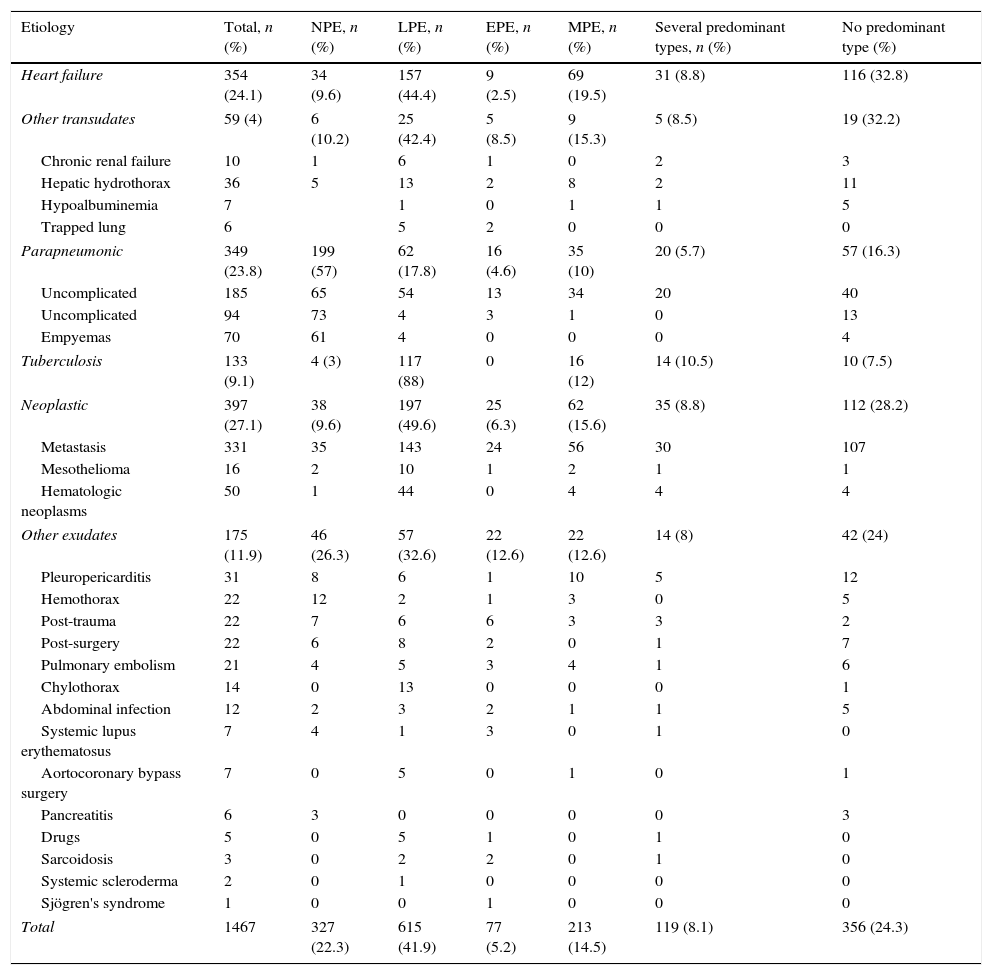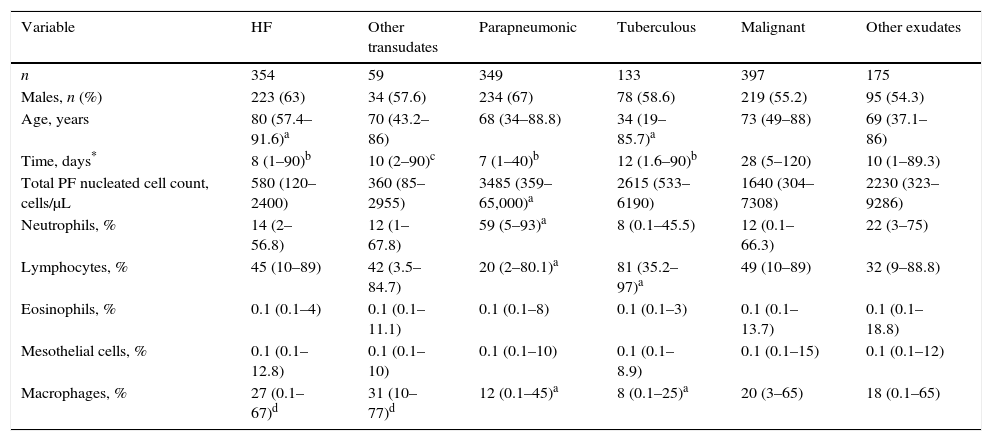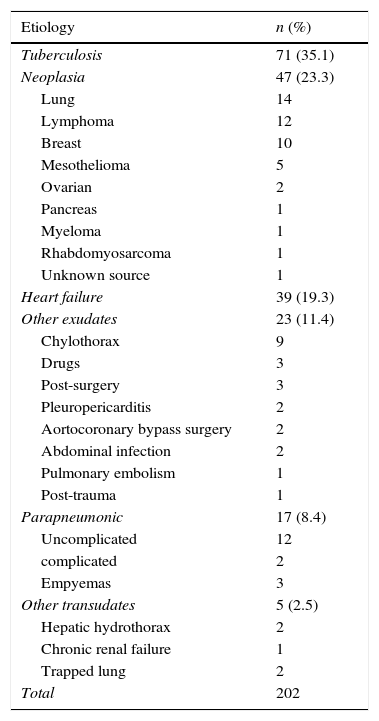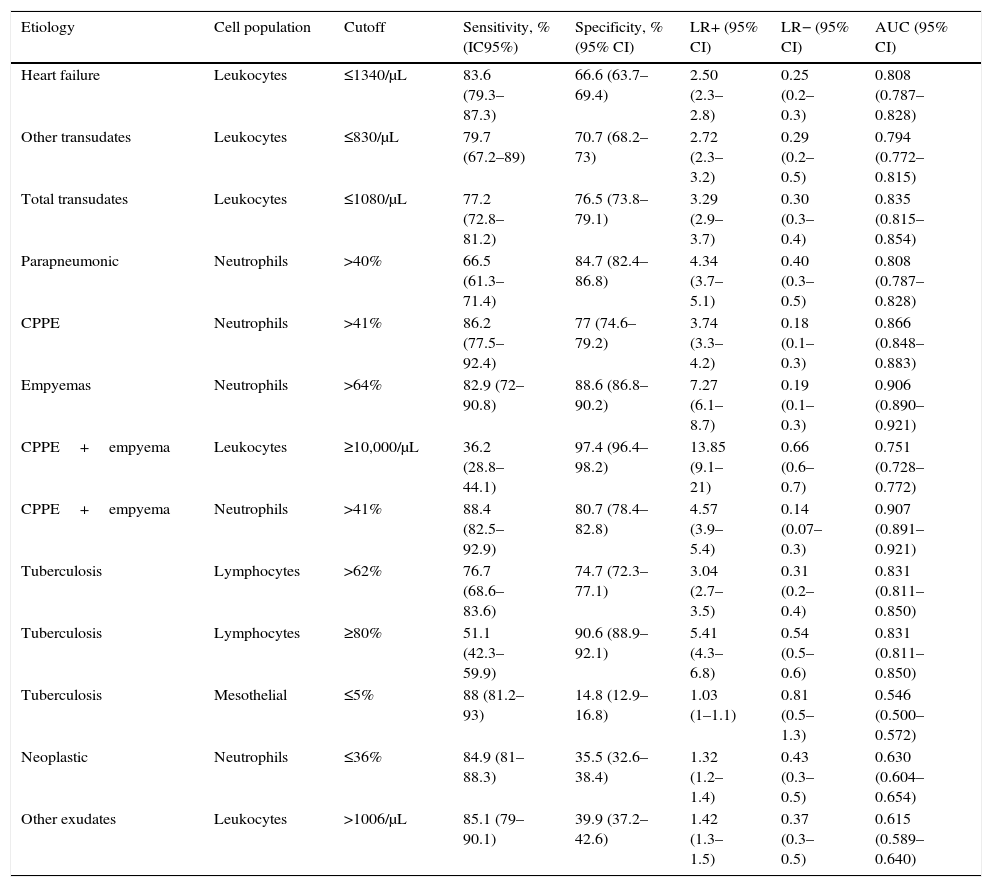To know the behavior of cellular components of pleural fluid can help focus the differential diagnosis of a pleural effusion. Our objective was to assess their composition in different types of pleural effusions and assess whether it provides relevant clinical information.
Patients and methodsObservational, cross-sectional and retrospective study in which the cellular components of pleural effusions of different etiology were analyzed. Pleural effusions were classified as neutrophilic, lymphocytic (≥50% of each one of them), eosinophilic (≥10%) or mesothelial (>5%) and were grouped into six diagnostic categories.
Results1467 patients were studied (354 heart failure, 59 other transudates, 349 paraneumonic, 133 tuberculous, 397 malignant and 175 other exudates). The predominance cell was lymphocytic in heart failure (44.4%), uncomplicated parapneumonic (29.2%), tuberculosis (88%) and malignant (49.6%); neutrophilic in parapneumonic (57%) and malignant (9.6%); eosinophilic in malignant (6.3%) and mesotelial in tuberculosis (12%). The most frequent etiologies with lymphocyte count ≥80% were tuberculosis (35.1%) and malignant (23.3%). Parameters with higher discriminating accuracy were: leukocytes (transudates: AUC 0.835) and percentage of neutrophils (empyemas: AUC 0.906 and complicated parapneumonic+empyemas: AUC 0.907).
ConclusionsNucleated cell counts will help focus the etiology of pleural effusions, since each etiology often have a characteristic cell predominance. The percentage of nucleated cells in pleural fluid not ruled out tuberculosis if there is a high count of mesothelial cells, nor a parapneumonic effusion with lymphocytic predominance, or malignancy with ≥80% lymphocytes.
El conocimiento del comportamiento de los componentes celulares del líquido pleural puede ayudar a enfocar el diagnóstico diferencial de un derrame pleural. El objetivo es evaluar su composición en los distintos tipos de derrames y valorar si proporciona información clínica relevante.
Pacientes y métodosEstudio observacional, transversal y retrospectivo en el que se analiza el componente celular de derrames pleurales de diversa etiología. Los derrames se clasificaron como neutrofílicos, linfocíticos (≥50% de cada uno de ellos), eosinofílicos (≥10%) o mesoteliales (>5%) y se agruparon en 6 categorías diagnósticas.
ResultadosSe estudiaron 1.467 pacientes (354 insuficiencia cardiaca; 59 otros trasudados; 349 paraneumónicos; 133 tuberculosos; 397 neoplásicos y 175 otros exudados). El predominio celular fue linfocítico en la insuficiencia cardiaca (44,4%), paraneumónicos no complicados (29,2%), tuberculosis (88%) y neoplasias (49,6%); neutrofílico en los paraneumónicos (57%) y neoplásicos (9,6%); eosinofílico en las neoplasias (6,3%) y mesotelial en las tuberculosis (12%). Las etiologías más frecuentes con un recuento linfocitario ≥80% fueron tuberculosis (35,1%) y neoplasias (23,3%). Los parámetros con mayor capacidad discriminante fueron: leucocitos (trasudados: AUC 0,835) y porcentaje de neutrófilos (empiemas: AUC 0,906 y paraneumónicos complicados + empiemas: AUC 0,907).
ConclusionesLos recuentos de células nucleadas ayudan a enfocar la etiología del derrame pleural, ya que cada etiología suele tener un predominio celular característico. El porcentaje de células nucleadas en el líquido pleural no puede descartar tuberculosis si existe un recuento elevado de células mesoteliales, ni un derrame paraneumónico ante un predominio linfocítico, o malignidad con un recuento de linfocitos ≥80%.
Article
Diríjase desde aquí a la web de la >>>FESEMI<<< e inicie sesión mediante el formulario que se encuentra en la barra superior, pulsando sobre el candado.

Una vez autentificado, en la misma web de FESEMI, en el menú superior, elija la opción deseada.

>>>FESEMI<<<











